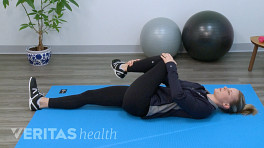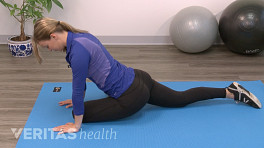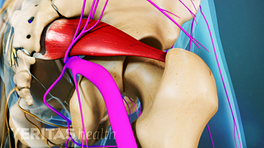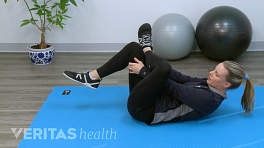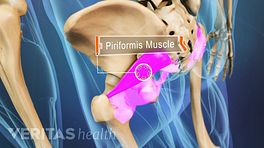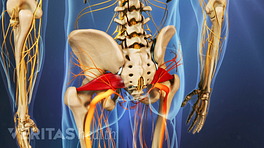Hi, everyone. I'm Natalie. And today, we're going to do a nine minute real time exercise routine for piriformis syndrome pain relief. It's important to note that if any of these exercises worsen your symptoms or cause new pain, please stop a consult with your medical provider.
We're going to be doing these exercises together in real time. So feel free to do them on the ground or on a bed, wherever you're most comfortable.
The first exercises I'm going to show you are going to be four different variations of piriformis stretching that help relieve tightness caused by piriformis musculature. We're going to do these first three on the ground.
You can lie on your back, and you can start with one leg, pulling your knee towards your chest, and then using your opposite hand to pull your knee towards your opposite shoulder. Start by holding for five seconds.
And then relax the stretch. Give it a break, and then we'll go into another five second hold. You should feel a stretch through your hip and buttock region here.
And we'll do one more repetition, holding for five seconds. Over time, you can work your way up 30 second holds with these stretches.
We'll do that same stretch on the other side. So pull your knee towards your chest. and then take your opposite hand, and pull towards your opposite shoulder. You can hold this one for five seconds. Relax come out of the stretch. We'll go for our second repetition. Relax, and then we'll do one more repetition.
If you didn't feel much of a stretch with that, or if it didn't provide relief, another variation you can do is bring your knee to your chest, and then grab your ankle. You'll pull your ankle towards you, and then pull towards your opposite shoulder, leading with the ankle.
Once again, you should feel a stretch to the buttock on hip area. We're going to hold for five seconds, and then relax, and we're going to do two more repetitions of that each side.
Good. And then you can switch to the other side. Pull your knee towards your chest. Use your other hand to grab your ankle, and pull it towards you. And then pull towards your opposite shoulder, leading with the ankle. Once again, hold for five seconds, and we'll do three repetitions.
Take a break. Take a break, and we'll do one more.
Good. If that piriformis is stretch was not comfortable for you, there's a third variation we can try. You'll start with the leg you want to stretch. Place your ankle across your other thigh, and then pull your thigh towards you. Hold for five seconds, and you should once again be feeling a stretch through the hip and buttock region.
Good. Take a break. We're going to work up to three sets of this. And we'll do one more set. You can then stretch the other side. Place your ankle across your knee. Then reach under your thigh and pull towards your chest. We'll do three for five seconds.
Good, and one more. Over time, as you get used to these stretches, you can work your way up, performing for 30 seconds.
The fourth one I'm going to show you requires a little bit more hip mobility, but is another great way to stretch out the piriformis and buttock region.
You're going to be on the ground or on your bed. Start on your hands and knees. You'll take the leg you want to stretch, pull it under your body, and then start to slide your other leg backwards.
Sink as low as you can comfortably, looking for a stretch through the outside of your hip and buttock region. You can hold for five seconds, and then rock forward to give yourself a little break. And then you can sink back into your second set.
Good. Take another break. We'll go for number three.
You can then go back to your hands and knees and take the other leg. Place it underneath you, and then slide your other leg back, sinking your hips towards the ground. After five seconds, rock out of it. Take a little break.
Sink back into a second set. Hold for five seconds.
Good. Take one more break, and hold for five seconds.
Those four structures are all great variations to help stretch the piriformis muscle. Next, I'm going to grab a towel and two chairs and show you guys some hamstring stretches.
Stretching the hamstrings is also an important part of relieving piriformis syndrome pain. There are two different ways you can do it that I'm going to show you.
First one, use a towel. You'll lie on your back, either on your bed or on the floor. You'll start with the leg you want to stretch. Place the towel around your foot, and then slowly straighten the knee, pulling back on the foot with the towel. Hold for five seconds, looking for a gentle stretch through the back of the thigh. And you can bend your knee to come out of the stretch for a second, and go back into your second set.
Good, and we'll do one more.
Good. Then you can switch to the other side. Loop the towel around your foot. And once again, straighten the knee into a gentle stretch, while pulling back on your foot. Hold for five seconds, and bend the knee to relax. We'll do two more of those.
Good. And over time, you can work up to performing this stretch for up to 30 seconds each side. If you're not comfortable lying down on your back, or if that stretch doesn't feel good for you, another option you can do involves two chairs or a chair and a stool or an Ottoman.
You'll sit on the edge of your chair, sitting up tall. Start with one heel on the other surface. And then lean forward from your hips until you feel a gentle stretch through the back of your leg. Start by holding for five seconds, just at a gentle stretch.
To come out of the stretch, you can lean back, take some pressure off your hamstrings, and then go back into a second set. Good, and relax, and we'll do one more.
Good. Then switch to the other side. Place your heel on the other surface. Sit up tall, and lean forward from your hips. You should feel a gentle stretch through the back of your leg.
We'll do a second set for five seconds. Relax, and we'll do one more.
It's important to note that if any of these exercises worsen your symptoms or cause new pain, please stop and consult with your medical provider. To learn more about piriformis syndrome, please visit us at Spine Health, and be sure to subscribe to our channel for more videos like this. Thank you for watching.


